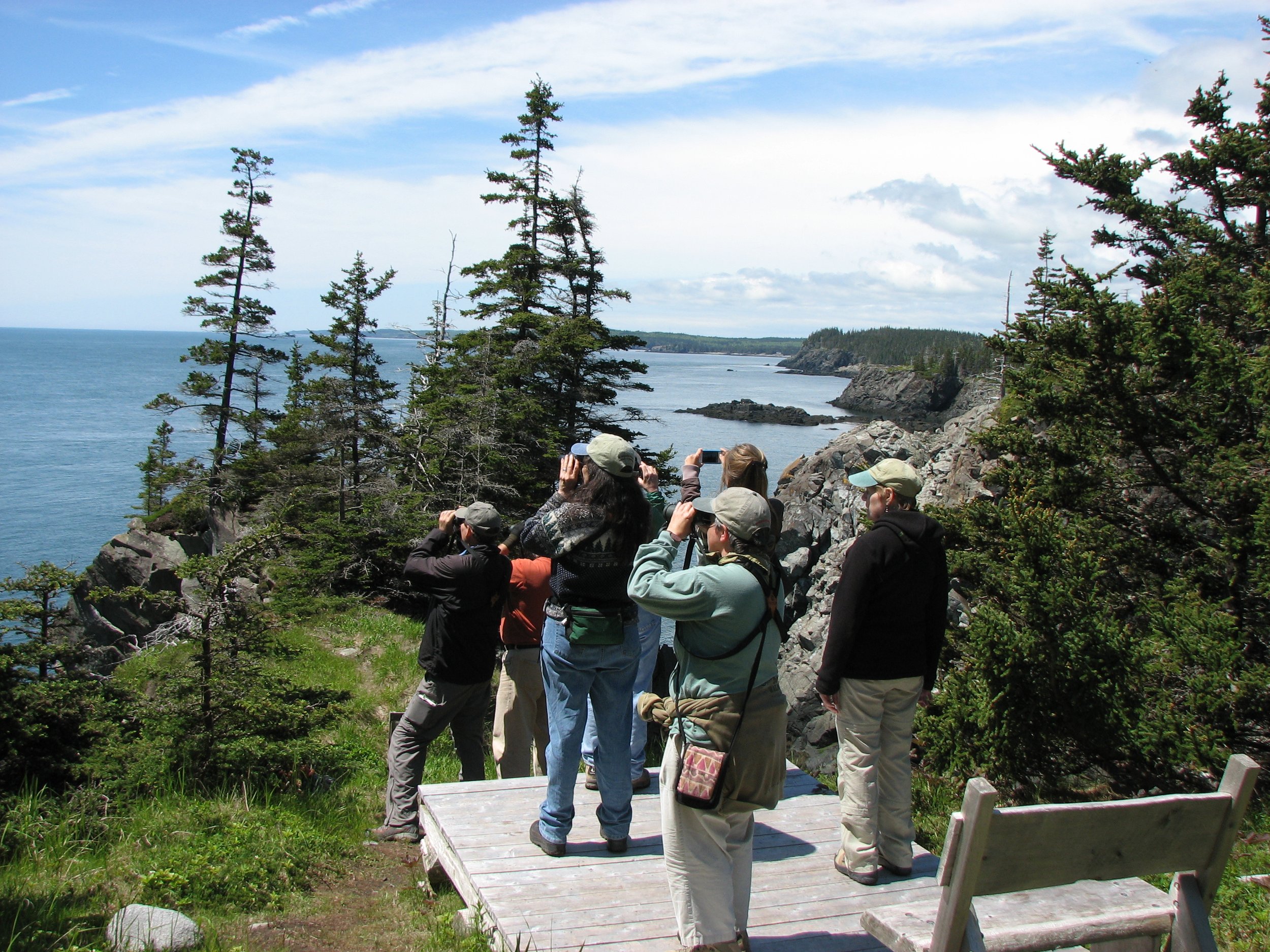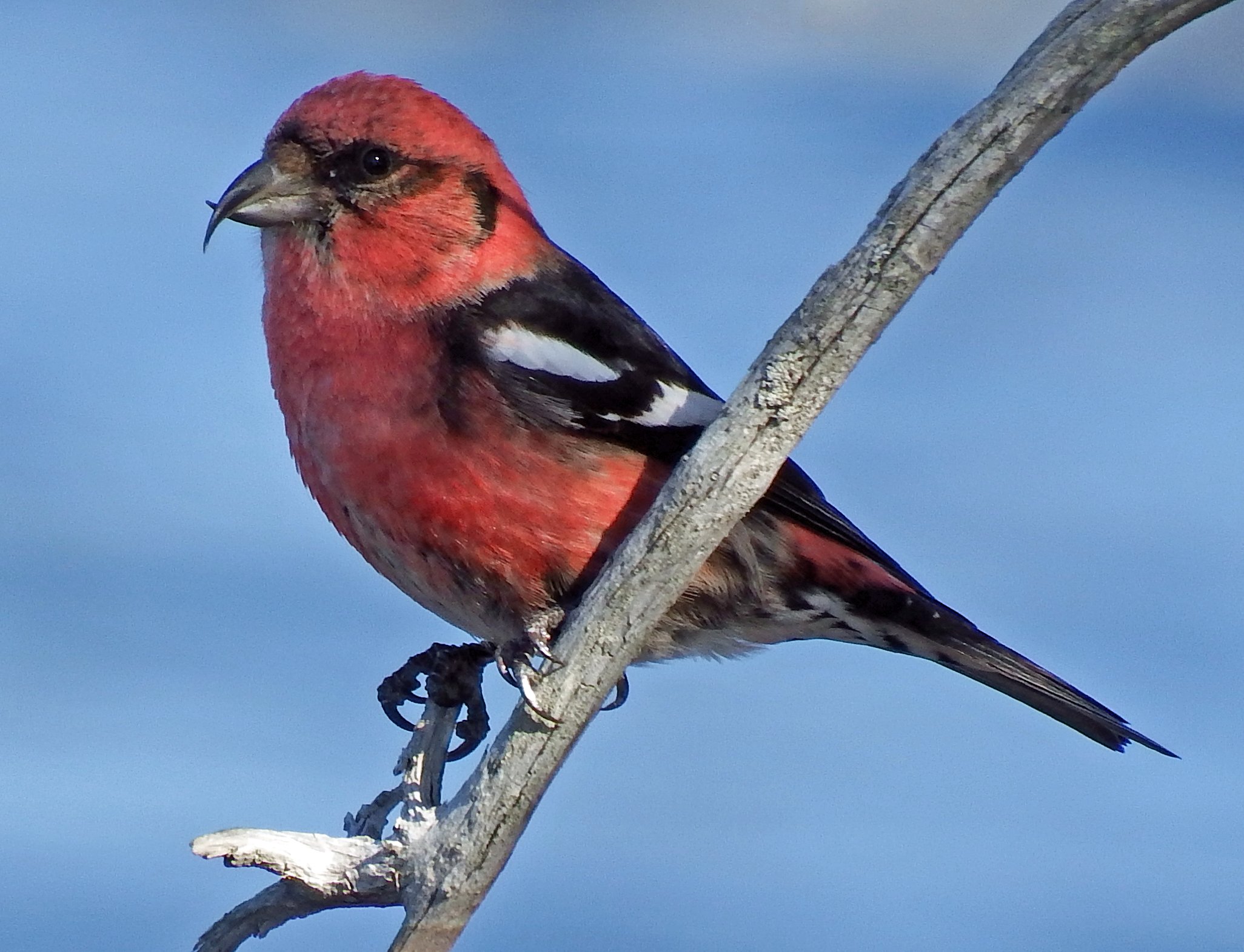Let’s go birding!
Maine’s richly diverse habitat is a magnet for hundreds of wild bird species.
Birders at Boot Head overlook in scenic Lubec, home to Quoddy Head State Park and the West Quoddy Lighthouse. The easy trail is less than a mile in length. Photo: Robert Duchesne
By Lynn Ascrizzi
IT’S ALWAYS A GREAT TIME TO celebrate birding in Maine—especially right now. This year marks the 100th anniversary of the signing of the Migratory Bird Treaty Act (MBTA), which passed in the U.S. in 1918. To honor the occasion, the National Geographic Society, Birdlife International, the National Audubon Society, the Cornell Lab of Ornithology and other groups have declared 2018 the Year of the Bird.
This important act has helped to protect several threatened species in Maine such as the Common Eider, the largest duck in the Northern hemisphere; the gorgeously patterned Wood Duck; the Common Tern, which nests on offshore islands; and the Brant, a small goose that winters along the Maine coast, according to the Natural Resources Council of Maine.
An adult male, white-winged Crossbill. This finch uses its crossed bill to separate pine cone scales and get at the seeds. Photo: Robert Duchesne
Habitats “for the birds”
Bird-watching is one of life’s delightful outdoor pursuits. As expert birder Robert “Bob” Duchesne of Hudson, Maine knows well, this big, rural state is the right place to enjoy it. In fact, he considers Maine a magnet for the roughly 380 kinds of wild birds that can be found here.
What creates this natural abundance? According to Duchesne, it has to do with “habitat transitions,” a geographical richness that sustains a great diversity of bird life. “Every bird has a niche it likes,” he explains, citing the wide array of habitats found in Maine, from the boreal forests of the North Woods, thick with spruce and fir, to the deciduous trees, like oaks, beech, birch and maples, that dominate the southern part of the state.
Another important habitat, he says, is found in the state’s southern coast, where you’re likely to see federally endangered birds like the Piping Plover and the Least Tern, which nest on sandy beaches. The rocky northern coast is home to species like gulls and Common Eiders, birds that nest on islands just offshore.
Additionally, Maine’s abundant wet terrain, such as marshes, bogs, lakes, ponds and rivers, provides habitat for loons, wild geese and ducks, and wading birds, like the American Bittern and the magnificent Great Blue Heron.
In the dry areas, such as the Kennebunk Plains, you’ll find Upland Sandpipers, Whippoorwills and Vesper Sparrows, Duchesne says. The Plains, which comprise 3,200 acres of protected sandplain grassland, are a last Northeast stronghold for endangered grassland birds.
On the bird-sighting trail
A Maine State Representative, Duchesne is also founder of the Maine Birding Trail website, mainebirdingtrail.com, a 14-year project that he created in collaboration with the Department of Conservation, the Maine Audubon Society and the Maine Department of Inland Fisheries and Wildlife. A one-stop resource for birding in Maine, it covers 385 miles of birding trails and 82 official birding sites, as well as birds you are likely to see by locale and by season. You can even find “best nests”— hotels, motels, B&Bs and other lodgings near bird trail sites.
Also at his website, under Trails, you can download the fabulous free booklet, “Maine Birding Trail,” that lists dozens of Maine birding sites, with directions and the birds you can expect to find at each region. The booklet is also available at Maine visitor centers.
A female Black-backed Woodpecker. Photo: Robert Duchesne
Duchesne has been tramping around the nooks and crannies of the state’s rugged, diverse terrain for 35 years and has personally sighted hundreds of species. “My number right now, in Maine, is 326 kinds of birds,” he says. He also leads professional birding tours and is the author of Maine Birding Trail, a paperback that describes 260 publicly accessible birding sites and the species found at those locations.
For him, spotting a hard-to-find species is always a big thrill. He recalls finding two species of woodpeckers in the northern forest that you won’t see south of Bangor, the American Three-toed Woodpecker and the Black Back Woodpecker. “They’re about the same size as the Hairy Woodpecker, but with yellow caps instead of red caps,” he explains. “They’re pretty rare. I saw them both once, in the same tree in the Chamberlain Lake area, west of Baxter State Park.”
One of his favorite species is the Spruce Grouse, which, as you might guess, lives in spruce forests. “It’s the darker cousin of the Ruffed Grouse. They’re so tame, you can walk right up to them.”
A public birding trail that Duchesne especially enjoys is at Boot Head Preserve, located off Boot Cove Road in Lubec. This Downeast area in the easternmost point of the United States is the home of Quoddy Head State Park and the West Quoddy Lighthouse and Visitor Center.
“It’s an easy trail, good for seniors and kids, with boards to walk over wet spots. It’s less than a mile to a scenic overlook,” he says. Birdwatchers can expect to see Bald Eagles, Black Guillemots, Common Eiders and songbirds. For more details, maps and directions to this and many other preserves that are perfect for birding, check out the Maine Coast Heritage Trust website: www.mcht.org.
Gear for better sighting
For birders anxious to find the right pair of binoculars, Duchesne advises that “more power is not necessarily better.” For instance, “A 10×50 is a big, powerful binocular. But at the end of the day, it’s too heavy,” he says. “The 7×35 or 8×42 range are often the most suitable.” He recommends going to a store and trying them. “Everyone’s eyes and hands are different.”
As for bird guidebooks, he recommends Sibley’s Guide to Eastern North American Birds. (Its second edition has significant updates.) “It is the most extensive—with more range maps than other guide books and good descriptions. And, it has good drawings of birds,” he says. For kids beginning to bird-watch, he recommends the small paperback Birds of Maine Field Guide by Stan Tekiela.
The Common Tern is one of five terns that breed in Maine. Medium-sized, with a bright red, blacktipped bill, it nests on Maine’s freshwater lakes as well as its offshore islands. Photo: Jeannette Lovitch
Conservation is key
Besides its combination of geography and habitat, Maine is also an exciting place to go birding because of its “fairly good history of conservation,” says birding tour guide and author Derek J. Lovitch, of Pownal. “We have a lot of open space and protected habitat. But we need to do a lot more,” he says, noting that consistent efforts to protect birding sites are integral to ensuring that the joy of birding and the celebration of birds continue for generations to come. “You can’t separate birding from conservation.”
Lovitch points out that the state has a wealth of nonprofit land trusts that act as stewards of the land they conserve, which greatly increases public access to the outdoors. Land trust terrain adds miles of free, publicly accessible trails, which include many spectacular scenic areas and rewarding bird sites. There are close to 100 land trusts in the state. To find a land trust in your area: www.mltn.org.
An Atlantic Puffin with a beakful of its preferred food — small fish, like herring and hake. Maine’s islands are the only nesting sites for Atlantic Puffins in the United States. Photo: Robert Duchesne
Out and about with the birds
Lovitch and his wife, Jeannette, own and operate Freeport Wild Bird Supply. He leads professional, organized bird tours here and throughout North America, including custom tours for all ages and levels of experience. He also leads free, 2-hour bird tours every Saturday morning, year-round from his store in Freeport. Interested birders can gather at the store at 8 a.m.
One of his fastest growing tours is the Birds On Tap℠ road trip series combining local craft beer and bird-watching. The birding and beer outings, for adults age 21-plus, combine tours to local birding hotspots, led by Lovitch, and guided tasting sessions at local breweries, wineries and distilleries. Birders of any skill level, including first timers, are welcome.
Lovitch is also the author and editor of Birdwatching in Maine: A Site Guide, published last year, with 201 places to go birding. The guide includes 10 contributors and provides an extensive treatment of the Portland area.
One of his favorite sites is Capisic Pond Park, an 18-acre nature preserve that offers moderately sloping trails through woods and fields and fine views of Portland’s largest freshwater pond. The trail is open from dawn to dusk, and benches are available.
A lot of birding, especially when trees are in full leaf, involves more bird-listening than bird-watching, he says. “Ears are just as important as your eyes. Hearing a birdcall helps you to detect where to look. And if you learn the bird songs, you can filter out common species and find a specific bird you’re looking for.”
Lovitch recommends seeking opportunities for “visible migrations.” The term refers to the daytime observation of birds during their intensive spring and fall migrations, two opportune times to sight lots of different kinds of birds.
One of his favorite visible migration spots is Sandy Point, on Cousin’s Island in Yarmouth. “It’s a great spot to view morning flight phenomenon, which occurs regularly in the hours after sunrise, in early August through early November,” he says.
The phenomenon compensates for “overnight drift,” he explains. “Most songbirds migrate at night. Birds that are drifting in the overnight winds need to compensate for the drift during the morning,” so they can find better habitat, avoid predators and realign their trajectory for the next flight.
Last year, Lovitch counted over 8,185 reorienting birds at the Sandy Point spot in less than four hours. “The most numerous species that day was the American Redstart,” he recalls. His experience illustrates how birding creates, for professional and recreational birders alike, an intangible but priceless connection to the awesome beauty to be found in Maine’s natural world. Happy birding!
The Spruce Grouse lives amid the thickly growing cover of spruce and fir. Photo: Bob Duchesne
Birding Highlights
Bug protection: During birding and other outings through Maine’s brushy fields and woodlands, it’s wise to safeguard against biting insects like mosquitoes and ticks, which can carry serious diseases. Bird trekkers should use a tick repellent, wear light-colored clothing, pull socks over pant legs and do vigilant tick checks during or right after every outing.
A Magnolia Warbler. Photo: Jeannette Lovitch
Acadia National Park
Mount Desert Island, Bar Harbor, Maine
A trip to the incredibly scenic Acadia National Park is at the top of many a birder’s bucket list. The park’s deciduous forests, open fields, evergreen forests, coastal regions, salt marshes, offshore islands, freshwater marshes and lakes are a haven for the hundreds of bird species to be found there. Ranger Guided Bird Walks are offered July through September. These popular walks fill early. Call the park for reservations, 288-3338.
Maine Audubon
Falmouth, Maine
Maine Audubon is situated in a modern educational center at Gilsland Farm, located along the Presumpscot River, about 5 miles from Portland. The 65-acre sanctuary offers more than 2 miles of gently rolling trails that wind along a pond and meander through forests, meadows, orchards and salt marsh. Look for Bobolinks, Meadowlarks and Glossy Ibises that forage in shallow marshes, and sparrows, warblers, thrushes and finches. Tidal flats support shorebirds. Maine Audubon also provides a list of some of the better-known Maine birding sites, including kinds of birds to look for and their habitats, in each of the state’s six regions: www.maineaudubon.org/birding.
Project Puffin Visitor Center
Rockland, Maine
Located at 311 Main Street in downtown Rockland, the center celebrates the success of Project Puffin in bringing the Atlantic Puffin and other rare Maine seabirds back to their historic nesting sites. View puffins and seabirds in real-time videos; get schedules for seabird-watching boat tours to Maine islands; see educational, interactive exhibits for all ages; learn about Audubon’s wildlife conservation projects; enjoy seabird art, photography and gift shop.









